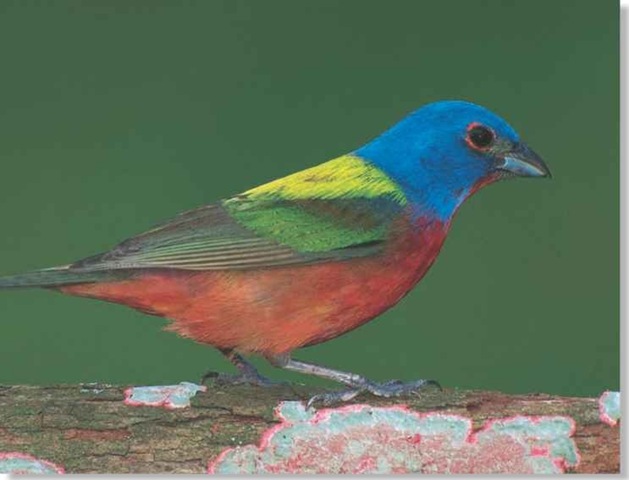ORDER
Passeriformes
FAMILY
Emberizidae
GENUS & SPECIES
KEY FEATURES
• Only the male sports the striking blue head and red underparts
• The male’s song advertises his presence to adversaries and potential mating partners
• Fiercely territorial, the painted bunting will engage in midair fights to protect its space
WHERE IN THE WORLD?
Found in the southern U.S. and south into Mexico and Cuba; winters from the Gulf of Mexico area to Central America
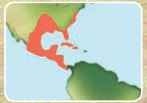
Lifecycle
The beautiful painted bunting rarely emerges from the deep plant cover it prefers; when it is visible, it is often fighting for territory with another bunting.
HABITAT
Within its range in North and Central America, the painted bunting frequents woodland edges where food and water are plentiful. It can also be found in thickets beside streams, gardens and roads.This highly territorial bird values its privacy and prefers to remain close to the protective cover of vegetation.
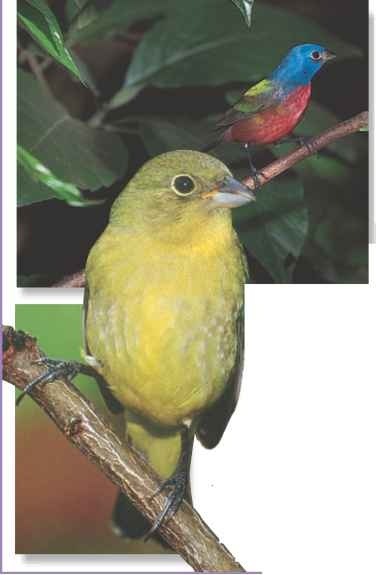
A Private perch The shy painted bunting prefers to perch in trees or shrubs well hidden in thickets vegetation.
Branch beauty Bursting with glorious color, a perched female painted bunting decorates a tropical tree branch.
BEHAVIOR
Practically the only time the normally shy painted bunting is visible is during its particularly fierce territorial battles. Males will protect their territories from intruding males through vicious fights, which can begin in the air and eventually end up on the ground. A bunting may also warn intruders with a threat posture, standing erect with its tail and head held high, forming its distinctive blue head feathers into a small crest. Once a bird is victorious, he sings to advertise his dominance and proclaim the territory as his own. After the breeding season, adult and young birds gather in loose flocks and fly south to warmer climates.
GET OFF MY BRANCH!
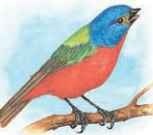
Warning…
The male painted bunting perches in a branch high in a tree, singing his warning call as he holds his head erect with the bill open.
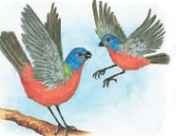
Serious posturing…
The highly territorial male stands up in a threatening posture, holding both his head and tail high as an intruding male flies nearby.
BREEDING
The male painted bunting arrives north first and establishes a well-defined territory, often occupying the same breeding area as the year before. Males perch at-prominent points and sing to establish territories. After chasing away potential suitors, the male sings a courtship song from his perch until a willing female appears. He then dives and chases her through the vegetation with such zeal that the pair sometimes ends up on the ground. After mating, the birds build a cup-shaped nest made of grasses, stalks and leaves in a bush or low tree, or in hanging Spanish moss about 25′ off the ground. The male dutifully feeds the female as she incubates the clutch of 3-5 pale-blue eggs for about I 2 days. After the young nestlings hatch, both parents feed the chicks until the fledglings leave the nest, about two weeks later Adults may raise up to four broods each breeding season.
Two’s company
Two bunting nestlings wait for their tardy sibling to hatch from its egg.
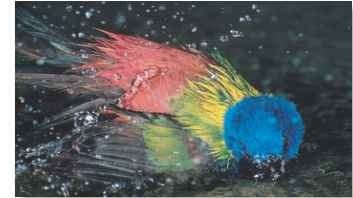
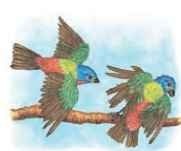
Intruder alert…
The intruding male swoops down and prepares to peck at the male on his perch; the other moves out of the way to avoid the attack.
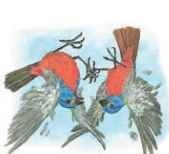
Fierce battle
The males twist and turn, feet locked, as they peck at each other with their sharp beaks; they may tumble toward the ground.
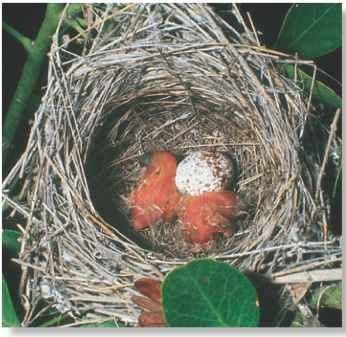
CONSERVATION
Although considered common by the National Audubon Society, the bunting is threatened by the loss of its breeding habitat due to the development of swampy thickets and woodland edges. In addition, hundreds of the birds are captured in their tropical wintering grounds each year for the pet trade.
FOOD & FEEDING
Both in the trees and on the ground, the painted bunting feeds on a variety of seeds, which comprise the majority of its diet. The bird’s stout, conical bill is well suited for crushing and husking seeds that are found scattered on the woodland floor. It also eats many insects, including caterpillars and flies. The painted bunting will forage most of the day and may also pluck various insects from the trees and surrounding bushes and shrubs to eat or to feed its nestlings.
Down the hatch A female bunting takes turns feeding its two hungry hatchlings.

According to Native American legend, the Great Spirit created the painted bunting from dabs of many colors left over after all the other birds were created.
The beauty of the painted bunting has inspired many names. Spanish speakers call it mariposa, the butterfly, while in the southern U.S. it is called nonpareil (without equal) for its peerless beauty.
Profile
Fainted Bunting
The painted bunting’s electrifying colors are easy to spot as the bird flies in quick bursts, defending its territory.
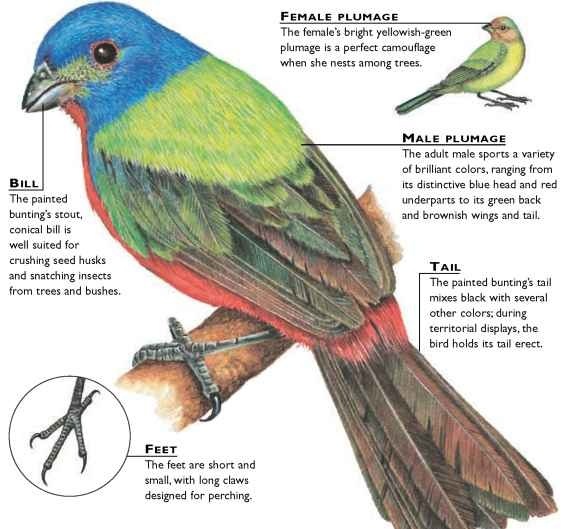
CREATURE COMPARISONS
The snow bunting (Plectrophenax nivalis) breeds in the colder climates of Iceland, Scandinavia, Scotland, subarctic Asia and North America, while the painted bunting enjoys a much milder climate; it is found in southern North America and Central America. Larger than the painted bunting at 6.25″, the snow bunting feeds on a similar diet of seeds and insects. It prefers open, stony country, tundra and mountains, and winters along the coasts. During breeding season, the male snow bunting is mainly pure white except for his black back, tail and primary feathers.
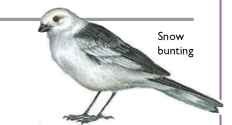
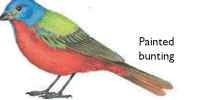
| VITAL Weight |
STATISTICS 0.5 oz. |
| Length | 5-5.5″ |
| Wingspan | 9-10″ |
| Sexual : Maturity | About 1 year |
| Breeding Season | March-July |
| Number of Eggs | 3-5 |
| Incubation Period | About 12 days |
| Fledging Period | 2 weeks |
| : Breeding Interval | Up to 4 broods per year |
| Typical Diet | Seeds, spiders and insects |
| Lifespan | Over 12 years |
RELATED SPECIES
• Among the 6 species in the genus Passerina are the indigo bunting, P. cyanea, and the lazuli ‘, bunting, P. amoena. The family Emberizidae contains 47 species, including the yellow warbler, Dendroica petechia, and the great-tailed grackle, Quiscalus mexicanus. The order Passeriformes contains a variety of birds, including larks, cardinals, crows and jays.
